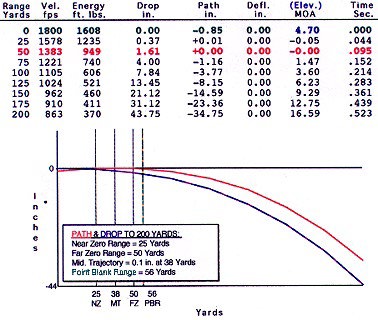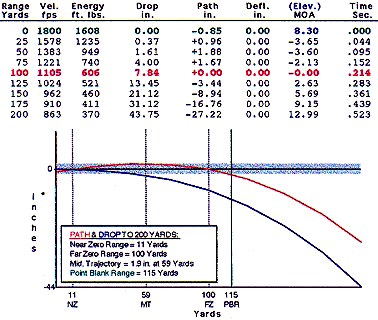
The perfect rifle would be one which shot a bullet in a perfectly straight line to all distances, so that all one had to do was point and shoot. Not even the most powerful, high velocity smokeless rifle shooting a scientifically designed bullet can do that, of course. All bullets travel to the target in a looping arc, first rising then falling toward the target. Because of the relatively low velocities and poor flight characteristics of the projectiles used in black powder rifles, the problem is compounded for them. Ballistics coefficients (BC) for all black powder projectiles are low, which is simply a way of saying they are poor at forcing their way through the air toward the target. High drag causes them to slow quickly, and this results in an exaggerated looping path to the target. This is true of conicals, but especially of roundball.
To the beginner trying to set his rifle up for hunting, this can seem a daunting problem. All is not lost, however. Working within the constraints imposed by the less than desirable flight characteristics of our chosen projectiles, it is quite easy to work out a flight path, a trajectory, which will serve us well in putting the bullet on target at a variety of ranges. If we do this well, we will be able to forget about the complications of that looping flight to the target and just 'point and shoot' as though we were shooting that theoretically perfect, laser-beam rifle.
There are some things which must be true, and which must be understood before we can do a good job of setting our rifle up in this way. If this is not so, the job will be impossible.
The first is that an optimal load has been worked out for the rifle. This means that you have tinkered with the powder charge, patch material, lubricant, ball or conical size, ramming pressure and anything else you can think of to make the rifle shoot consistently good groups. Once you have worked out this load, you shoot it every time. Depending upon the game you are hunting, this may be anything from a pip-squeak load for small game, up close, to a real heller of a load for big game, way over yonder. It may be a .30 caliber pea-shooter or a .75 caliber musket. The range at which you shoot those good groups in not important, only that they are consistent. Why? Because consistency in groups is the sign of consistency in velocity, and that's something we must have. All calculations of ballistic trajectories assume a consistent velocity from shot to shot, and if that isn't true, all bets are off. It's the same as shooting a bow. We draw a bow to exactly the same point every time, and shoot the same weight arrows every time. By doing so, we guarantee the same velocity from shot to shot, and then that aiming point will work. Otherwise, you may as well throw rocks. In the same way, if we add powder and thus increase the velocity, the trajectory will change, and the rifle will shoot high. Reduce the powder charge and the rifle will shoot low, because we have decreased velocity, changing the trajectory. So, optimum load means consistent velocity, consistent trajectory.
The second factor is a matter of understanding exactly what is meant by the term 'trajectory'. Of course, we all know that means the path of the bullet, but there's one aspect of this which is critical to using our knowledge to work out a solution to our problem. That is the fact that the shape of that trajectory, that arcing curve, is absolutely fixed, always the same, for any given velocity. If we shoot the same bullet at the same velocity 100 times, the bullet will travel in exactly the same path each and every time, as though it were on a track. Understanding this fact is the key to working out the practical hunting trajectory we are looking for.
With those two factors in mind, our problem boils down to a simple question of where we are going to point the rifle, or to use more accepted terms, how are we going to sight the rifle in? There seem to be as many opinions about this as there are shooters. This whole discussion is my opinion on how it should be done.
Many hunters, for whatever reason, sight their rifles in for too short a range. By doing so, they lose much of the potential of the gun and make the job of hitting accurately with it over a variety of ranges very difficult. To illustrate this, we'll look at two trajectory charts generated by Gun Controller®, by RSI. Because I'm strictly a roundball shooter, they will illustrate roundball trajectories, but everything we will discuss is exactly the same for conicals. The charts show the trajectory for a .530 inch lead ball of 223.5 grains weight, fired at a velocity of 1800 fps. All parameters for the two charts are exactly the same except for the distance at which the rifle is sighted in. First, consider what we get if we sight the rifle in for 50 yards. On the plot, the line-of-sight is shown as a straight black line at the top, marked with a "0" , and the path of the ball is shown in red. Drop is the curved blue line, but that's of no concern to us now.

It is easily seen that the path of the bullet deviates very little from the line of the sights out to 50 yards, rising to only 0.13 inches above it (Mid-Range Trajectory) at 38 yards. Notice, though, that at 100 yards the ball is 3.77 inches low, and at 125 yards it is 8.15 inches low. A definition must be discussed here, that of Point Blank Range. Technically, it is the range at which the ball falls as far below the line of sight as it had risen above it at the Mid-Range Trajectory. Practically, it means something more useful to us, and that is the range at which we can pretend the rifle is doing just exactly what we would like it to do, shoot in a perfectly straight line. Point Blank Range is given as 56 yards in this chart, and that means that for any target from the muzzle out to 56 yards we can just point and shoot, and we will hit. Out at 125 yards, though, where the ball shoots 8.15 inches low with the rifle sighted for 50 yards, it will require some good guessing to put the ball where we want it.
Now, let us consider the situation if we sight the rifle in for 100 yards, not 50 yards.

Considering this chart for the same measurements as before, it immediately becomes apparent that the ball rises farther above the line-of-sight, as the Mid-Range Trajectory is given as 1.9 inches. Of course, the ball is exactly on target at 100 yards, but look at 125 yards. It has fallen only 3.44 inches below line of sight, as opposed to 8.15 inches in the 50 yard chart. So, the ball now deviates more above the line-of-sight , but less below the line-of-sight out to 125 yards. Most importantly, notice that the point Blank Range has increased from 56 yards to an impressive 115 yards. In this instance, that means that from the muzzle to 115 yards out, the ball will not deviate from line-of-sight by more than 1.9 inches high or low, or not outside a circle of 3.8 inches. It also means that out to 115 yards there is no need to guess where the ball will go, but that we can just point and shoot out to that range.
Under big game hunting conditions, that is certainly acceptable. In fact, it's very good, because it's better than most of us will shoot in that situation.
It's important to realize what has happened, why the difference in the numbers for the two charts. Remember that the velocity and all other parameters are the same for each shot, and the only difference is how we have sighted the rifle in. The shape of the trajectory is exactly the same on each chart. We have simply decided to use a different area of that shape, by raising the shape up a little at the downrange end, only. We did this by sighting the rifle for a greater range, thus gaining a significant increase in versatility and making unnecessary a lot of semi-intelligent guessing as to where the bullet will hit at a fairly long range.
Simply stated, all we need to do is to sight the rifle for the maximum distance at which the Mid-Range Trajectory is not great enough to cause us to miss. Sighting the rifle for that possible long shot, instead of the expected short one, is always wise. This method of sighting a rifle makes the most effective use of the gun. It allows us to hit our target at any range out to the Point Blank Range, quickly and under pressure, and we don't even have to know what range we are shooting at, so long as it is less than the Point Blank Range. I recommend it highly for all hunting rifles to be used on big game.
The principle is the same with all types of rifle shooting, of course, but it may not be the best method to use in all circumstances. Hunting small game frequently requires hitting very small targets at limited ranges. It does me no good to sight my squirrel rifle in for 75 yards when most every shot is at 25 yards or less. Sighted for 75 yards, the Mid-Range Trajectory, the maximum rise of the ball above line-of-sight, might be great enough to cause me to miss, even at 25 yards. It is more practical to sight the rifle for 25 yards and know that there is no significant deviation from line of sight out to that range. I don't care what happens to the ball, as far as drop is concerned, out beyond that range, because I never shoot beyond it.
Target shooters firing only at targets of known distance, never at a variety of ranges, are better advised to sight the rifle for that range and forget about Mid-Range Trajectory and Drop. If they are required to shoot fixed sights at a variety of ranges, though, this method will work very well.
This approach has worked very well for me in a wide variety of hunting situations for both large and small game. In my hands, it works best if I use the Center Hold sight picture for all my shooting. In the woods under less than ideal lighting conditions, with the range only guessed at and the situation changing constantly as I try to get the shot off, it would be be a waste of time and effort having to remember that I'm sighted in for a Six O'clock hold and to make adjustments for that. Point and shoot, that's what works best for me. Thinking comes later, sipping a hot cup of coffee while roasting venison loin on a stick over a cheery fire.
©1997 B. E. Spencer